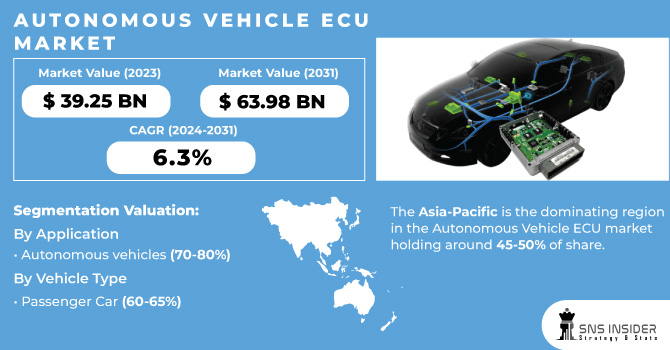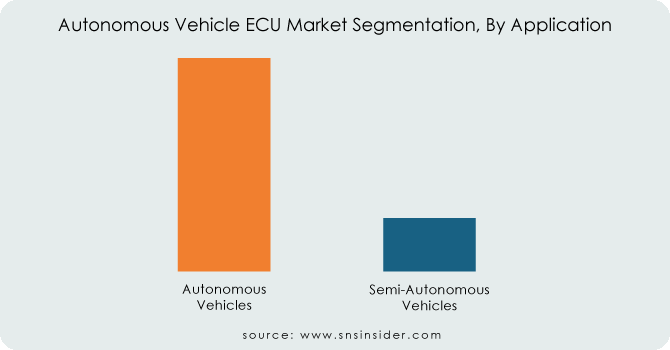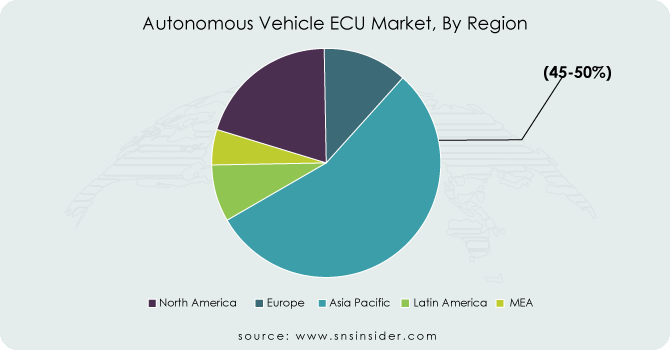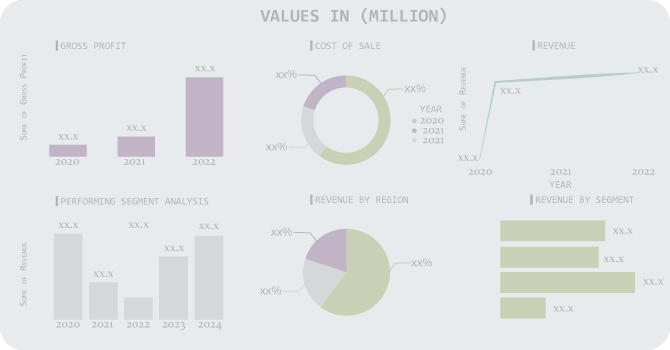The Autonomous Vehicle ECU Market Size was valued at USD 39.25 billion in 2023 and is expected to reach USD 63.98 billion by 2031 and grow at a CAGR of 6.3% over the forecast period 2024-2031.
The electronic control unit (ECU) is the vital component of a car, managing functions like engines, entertainment systems, and advanced driver-assistance systems (ADAS) through sensors and components. Autonomous vehicle ECUs are especially crucial for safety features like lane departure monitoring and collision avoidance. This market is driven by stricter government safety regulations, a growing demand for ADAS features, and rising vehicle sales. To improve safety and traffic flow, car manufacturers are developing new technologies. Affordable advanced safety features like blind spot detection and automatic emergency braking are also boosting the market. Stringent regulations, like mandatory ABS systems further propel market growth. The main driver, however, is the concerning rise in accidents due to human error, like fatigue from long drives.

Get more information on Autonomous Vehicle ECU Market - Request Free Sample Report
KEY DRIVERS:
Advanced Sensor Tech Drives Growth in Autonomous Vehicle ECU Market
Autonomous vehicles rely heavily on advanced sensors for safe navigation. This market thrives because of constant improvements in LiDAR, radar, cameras, and other perception systems. These high-tech sensors are the crucial part of the car, feeding real-time data on the environment to the Electronic Control Unit (ECU), the vehicle's brain. This vital data allows the ECU to make critical decisions and navigate autonomously.
Automotive Industry Collaboration Drives Innovation in Autonomous Vehicle ECUs
RESTRAINTS:
The high cost of developing and integrating advanced sensors and powerful processors in ECUs can limit adoption.
Concerns regarding data security and potential hacking vulnerabilities in autonomous vehicle ECUs can deter market expansion.
OPPORTUNITIES:
Advancements in sensor technology like LiDAR and radar will create a demand for more powerful ECUs to process the complex data.
Growing adoption of ADAS features in regular vehicles can serve as a stepping stone towards autonomous ECUs.
CHALLENGES:
High Development Costs hinders Autonomous Vehicle ECU Market Growth
Bringing complex autonomous vehicle ECUs to market is expensive. Extensive testing in various situations is crucial to guarantee safety and reliability, driving up development costs. This can be a barrier for smaller companies. The challenge lies in optimizing testing procedures to make them more efficient without sacrificing safety. Thus, ensuring safe and reliable ECUs requires thorough testing across different situations, making development costly.
The war in Russia-Ukraine disrupts the promising growth of the Autonomous Vehicle ECU market. Disruptions to production and export of vital car parts, including the semiconductors essential for ECUs, could cause a temporary decline of 15-20% in ECU production. This setback impacts not only the autonomous vehicle but also the broader ADAS market that relies on similar technology. The slowdown extends to raw material supplies, as both Russia and Ukraine are key players in certain materials needed for ECU manufacturing. The war's overall impact on the market depends on the conflict's duration and the effectiveness of alternative supply chains. While the short-term outlook is decreased, the long-term growth prospects of the Autonomous Vehicle ECU market remain positive, driven by the above factors like stricter safety regulations and rising demand for ADAS features.
An economic slowdown can disrupt the promising growth of thew autonomous vehicle ECU market. Consumer spending typically limits during economic downturns, potentially leading to a 10-15% decline in overall vehicle sales. This directly translates to a decrease in demand for new vehicles, including those equipped with advanced ECUs. Additionally, economic hardship can force car manufacturers to prioritize short-term profits over long-term investments in cutting-edge technologies like autonomous driving. This may lead to delays in research and development projects focused on next-generation ECUs.
By Application
Autonomous vehicles
Semi-autonomous vehicles
Autonomous vehicles is the dominating sub-segment in the Autonomous Vehicle ECU Market by application holding around 70-80% of market share. This dominance is driven by the sheer complexity of these vehicles. They require powerful ECUs capable of handling massive amounts of data from various sensors (LiDAR, radar, cameras) and making real-time decisions for safe navigation in dynamic environments.

Get Customized Report as per your Business Requirement - Request For Customized Report
By Vehicle Type
Passenger car
Light commercial vehicle
Heavy commercial vehicle
Passenger is the dominating sub-segment in the Autonomous Vehicle ECU Market by vehicle type holding around 60-65 % of market share. The passenger car segment is much larger than commercial vehicles. Secondly, there's a growing consumer demand for comfort and safety features in passenger cars, pushing the adoption of ADAS and paving the way for autonomous technology.
REGIONAL ANALYSES
The Asia-Pacific is the dominating region in the Autonomous Vehicle ECU market holding around 45-50% of share. This region's rising automotive industry, creates a massive market for these specialized ECUs. The government support for autonomous vehicle development and the growing popularity of electric vehicles, which often come equipped with advanced driver-assistance systems, further fuel market growth in this region.
North America is the second highest region in this market with a 30-35% share, due to the presence of major automakers like Ford, GM, and Tesla who are heavily invested in autonomous technology.
Europe boasts the fastest growth with a 20-25% of share due to its stringent safety regulations. These regulations push car manufacturers to adopt advanced driver-assistance systems and autonomous technologies, requiring high-performance ECUs.

REGIONAL COVERAGE:
North America
US
Canada
Mexico
Europe
Eastern Europe
Poland
Romania
Hungary
Turkey
Rest of Eastern Europe
Western Europe
Germany
France
UK
Italy
Spain
Netherlands
Switzerland
Austria
Rest of Western Europe
Asia Pacific
China
India
Japan
South Korea
Vietnam
Singapore
Australia
Rest of Asia Pacific
Middle East & Africa
Middle East
UAE
Egypt
Saudi Arabia
Qatar
Rest of the Middle East
Africa
Nigeria
South Africa
Rest of Africa
Latin America
Brazil
Argentina
Colombia
Rest of Latin America
The major key players are Continental AG (Germany), Robert Bosch (Germany), Infineon Technologies AG (Germany), Hitachi, Ltd. (Japan), Intel Corporation (U.S.), Nvidia Corporation (U.S.), and Renesas Electronics Corporation (Japan), ZF Friedrichshafen AG (Germany), NXP Semiconductors N.V. (Netherlands), Autoliv Inc. (Sweden) and other key players.

In June 2020: NXP Semiconductors and Microsoft joined forces in a strategic partnership to create new automotive solutions. This collaboration indicates potential for advancements in the automotive industry.
In July 2020: Autoliv, a leading automotive safety company, has introduced the EyeQ5 Advanced Driver Assistance System (ADAS). This system is designed to enhance safety on the roads by providing features like lane departure warning and collision avoidance.
In August 2020: Continental AG has introduced the car security with their new Automotive Cyber Security Suite. This advanced system offers increased protection against cyberattacks, making vehicles safer on the road.
| Report Attributes | Details |
|---|---|
| Market Size in 2023 | US$ 39.25 Billion |
| Market Size by 2031 | US$ 63.98 Billion |
| CAGR | CAGR of 6.3% From 2024 to 2031 |
| Base Year | 2023 |
| Forecast Period | 2024-2031 |
| Historical Data | 2020-2022 |
| Report Scope & Coverage | Market Size, Segments Analysis, Competitive Landscape, Regional Analysis, DROC & SWOT Analysis, Forecast Outlook |
| Key Segments | • By Application (Autonomous vehicles, Semi-autonomous vehicles) • By Vehicle Type (Passenger car, Light commercial vehicle, Heavy commercial vehicle) |
| Regional Analysis/Coverage | North America (US, Canada, Mexico), Europe (Eastern Europe [Poland, Romania, Hungary, Turkey, Rest of Eastern Europe] Western Europe] Germany, France, UK, Italy, Spain, Netherlands, Switzerland, Austria, Rest of Western Europe]), Asia Pacific (China, India, Japan, South Korea, Vietnam, Singapore, Australia, Rest of Asia Pacific), Middle East & Africa (Middle East [UAE, Egypt, Saudi Arabia, Qatar, Rest of Middle East], Africa [Nigeria, South Africa, Rest of Africa], Latin America (Brazil, Argentina, Colombia, Rest of Latin America) |
| Company Profiles | Continental AG (Germany), Robert Bosch (Germany), Infineon Technologies AG (Germany), Hitachi, Ltd. (Japan), Intel Corporation (U.S.), Nvidia Corporation (U.S.), and Renesas Electronics Corporation (Japan), ZF Friedrichshafen AG (Germany), NXP Semiconductors N.V. (Netherlands), Autoliv Inc. (Sweden) |
| Key Drivers | • Advanced Sensor Tech Drives Growth in Autonomous Vehicle ECU Market • Automotive Industry Collaboration Drives Innovation in Autonomous Vehicle ECUs |
| Restraints | • The high cost of developing and integrating advanced sensors and powerful processors in ECUs can limit adoption. • Concerns regarding data security and potential hacking vulnerabilities in autonomous vehicle ECUs can deter market expansion. |
Ans: The expected CAGR of the global Autonomous Vehicle ECU Market during the forecast period is 6.3%.
Ans: The Autonomous Vehicle ECU Market was valued at USD 39.25 billion in 2023.
Ans: Advanced sensor technology and stricter government safety regulations are key drivers.
Ans: Asia-Pacific dominates the market due to its booming automotive industry and government support for autonomous vehicles.
Ans: Continental AG, Robert Bosch, and Infineon Technologies are among the key players.
Table of Contents
1. Introduction
1.1 Market Definition
1.2 Scope
1.3 Research Assumptions
2. Industry Flowchart
3. Research Methodology
4. Market Dynamics
4.1 Drivers
4.2 Restraints
4.3 Opportunities
4.4 Challenges
5. Impact Analysis
5.1 Impact of Russia Ukraine Crisis
5.2 Impact of Economic Slowdown on Major Countries
5.2.1 Introduction
5.2.2 United States
5.2.3 Canada
5.2.4 Germany
5.2.5 France
5.2.6 UK
5.2.7 China
5.2.8 Japan
5.2.9 South Korea
5.2.10 India
6. Value Chain Analysis
7. Porter’s 5 Forces Model
8. Pest Analysis
9. Autonomous Vehicle ECU Market Segmentation, By Application
9.1 Introduction
9.2 Trend Analysis
9.3 Autonomous vehicles
9.4 Semi-autonomous vehicles
10. Autonomous Vehicle ECU Market Segmentation, By Vehicle Type
10.1 Introduction
10.2 Trend Analysis
10.3 Passenger car
10.4 Light commercial vehicle
10.5 Heavy commercial vehicle
11. Regional Analysis
11.1 Introduction
11.2 North America
11.2.1 Trend Analysis
11.2.2 North America Autonomous Vehicle ECU Market Segmentation, by Country
11.2.3 North America Autonomous Vehicle ECU Market Segmentation, By Application
11.2.4 North America Autonomous Vehicle ECU Market Segmentation, By Vehicle Type
11.2.5 USA
11.2.5.1 USA Autonomous Vehicle ECU Market Segmentation, By Application
11.2.5.2 USA Autonomous Vehicle ECU Market Segmentation, By Vehicle Type
11.2.6 Canada
11.2.6.1 Canada Autonomous Vehicle ECU Market Segmentation, By Application
11.2.6.2 Canada Autonomous Vehicle ECU Market Segmentation, By Vehicle Type
11.2.7 Mexico
11.2.7.1 Mexico Autonomous Vehicle ECU Market Segmentation, By Application
11.2.7.2 Mexico Autonomous Vehicle ECU Market Segmentation, By Vehicle Type
11.3 Europe
11.3.1 Trend Analysis
11.3.2 Eastern Europe
11.3.2.1 Eastern Europe Autonomous Vehicle ECU Market Segmentation, by Country
11.3.2.2 Eastern Europe Autonomous Vehicle ECU Market Segmentation, By Application
11.3.2.3 Eastern Europe Autonomous Vehicle ECU Market Segmentation, By Vehicle Type
11.3.2.4 Poland
11.3.2.4.1 Poland Autonomous Vehicle ECU Market Segmentation, By Application
11.3.2.4.2 Poland Autonomous Vehicle ECU Market Segmentation, By Vehicle Type
11.3.2.5 Romania
11.3.2.5.1 Romania Autonomous Vehicle ECU Market Segmentation, By Application
11.3.2.5.2 Romania Autonomous Vehicle ECU Market Segmentation, By Vehicle Type
11.3.2.6 Hungary
11.3.2.6.1 Hungary Autonomous Vehicle ECU Market Segmentation, By Application
11.3.2.6.2 Hungary Autonomous Vehicle ECU Market Segmentation, By Vehicle Type
11.3.2.7 Turkey
11.3.2.7.1 Turkey Autonomous Vehicle ECU Market Segmentation, By Application
11.3.2.7.2 Turkey Autonomous Vehicle ECU Market Segmentation, By Vehicle Type
11.3.2.8 Rest of Eastern Europe
11.3.2.8.1 Rest of Eastern Europe Autonomous Vehicle ECU Market Segmentation, By Application
11.3.2.8.2 Rest of Eastern Europe Autonomous Vehicle ECU Market Segmentation, By Vehicle Type
11.3.3 Western Europe
11.3.3.1 Western Europe Autonomous Vehicle ECU Market Segmentation, by Country
11.3.3.2 Western Europe Autonomous Vehicle ECU Market Segmentation, By Application
11.3.3.3 Western Europe Autonomous Vehicle ECU Market Segmentation, By Vehicle Type
11.3.3.4 Germany
11.3.3.4.1 Germany Autonomous Vehicle ECU Market Segmentation, By Application
11.3.3.4.2 Germany Autonomous Vehicle ECU Market Segmentation, By Vehicle Type
11.3.3.5 France
11.3.3.5.1 France Autonomous Vehicle ECU Market Segmentation, By Application
11.3.3.5.2 France Autonomous Vehicle ECU Market Segmentation, By Vehicle Type
11.3.3.6 UK
11.3.3.6.1 UK Autonomous Vehicle ECU Market Segmentation, By Application
11.3.3.6.2 UK Autonomous Vehicle ECU Market Segmentation, By Vehicle Type
11.3.3.7 Italy
11.3.3.7.1 Italy Autonomous Vehicle ECU Market Segmentation, By Application
11.3.3.7.2 Italy Autonomous Vehicle ECU Market Segmentation, By Vehicle Type
11.3.3.8 Spain
11.3.3.8.1 Spain Autonomous Vehicle ECU Market Segmentation, By Application
11.3.3.8.2 Spain Autonomous Vehicle ECU Market Segmentation, By Vehicle Type
11.3.3.9 Netherlands
11.3.3.9.1 Netherlands Autonomous Vehicle ECU Market Segmentation, By Application
11.3.3.9.2 Netherlands Autonomous Vehicle ECU Market Segmentation, By Vehicle Type
11.3.3.10 Switzerland
11.3.3.10.1 Switzerland Autonomous Vehicle ECU Market Segmentation, By Application
11.3.3.10.2 Switzerland Autonomous Vehicle ECU Market Segmentation, By Vehicle Type
11.3.3.11 Austria
11.3.3.11.1 Austria Autonomous Vehicle ECU Market Segmentation, By Application
11.3.3.11.2 Austria Autonomous Vehicle ECU Market Segmentation, By Vehicle Type
11.3.3.12 Rest of Western Europe
11.3.3.12.1 Rest of Western Europe Autonomous Vehicle ECU Market Segmentation, By Application
11.3.2.12.2 Rest of Western Europe Autonomous Vehicle ECU Market Segmentation, By Vehicle Type
11.4 Asia-Pacific
11.4.1 Trend Analysis
11.4.2 Asia Pacific Autonomous Vehicle ECU Market Segmentation, by Country
11.4.3 Asia Pacific Autonomous Vehicle ECU Market Segmentation, By Application
11.4.4 Asia Pacific Autonomous Vehicle ECU Market Segmentation, By Vehicle Type
11.4.5 China
11.4.5.1 China Autonomous Vehicle ECU Market Segmentation, By Application
11.4.5.2 China Autonomous Vehicle ECU Market Segmentation, By Vehicle Type
11.4.6 India
11.4.6.1 India Autonomous Vehicle ECU Market Segmentation, By Application
11.4.6.2 India Autonomous Vehicle ECU Market Segmentation, By Vehicle Type
11.4.7 Japan
11.4.7.1 Japan Autonomous Vehicle ECU Market Segmentation, By Application
11.4.7.2 Japan Autonomous Vehicle ECU Market Segmentation, By Vehicle Type
11.4.8 South Korea
11.4.8.1 South Korea Autonomous Vehicle ECU Market Segmentation, By Application
11.4.8.2 South Korea Autonomous Vehicle ECU Market Segmentation, By Vehicle Type
11.4.9 Vietnam
11.4.9.1 Vietnam Autonomous Vehicle ECU Market Segmentation, By Application
11.4.9.2 Vietnam Autonomous Vehicle ECU Market Segmentation, By Vehicle Type
11.4.10 Singapore
11.4.10.1 Singapore Autonomous Vehicle ECU Market Segmentation, By Application
11.4.10.2 Singapore Autonomous Vehicle ECU Market Segmentation, By Vehicle Type
11.4.11 Australia
11.4.11.1 Australia Autonomous Vehicle ECU Market Segmentation, By Application
11.4.11.2 Australia Autonomous Vehicle ECU Market Segmentation, By Vehicle Type
11.4.12 Rest of Asia-Pacific
11.4.12.1 Rest of Asia-Pacific Autonomous Vehicle ECU Market Segmentation, By Application
11.4.12.2 Rest of Asia-Pacific Autonomous Vehicle ECU Market Segmentation, By Vehicle Type
11.5 Middle East & Africa
11.5.1 Trend Analysis
11.5.2 Middle East
11.5.2.1 Middle East Autonomous Vehicle ECU Market Segmentation, by Country
11.5.2.2 Middle East Autonomous Vehicle ECU Market Segmentation, By Application
11.5.2.3 Middle East Autonomous Vehicle ECU Market Segmentation, By Vehicle Type
11.5.2.4 UAE
11.5.2.4.1 UAE Autonomous Vehicle ECU Market Segmentation, By Application
11.5.2.4.2 UAE Autonomous Vehicle ECU Market Segmentation, By Vehicle Type
11.5.2.5 Egypt
11.5.2.5.1 Egypt Autonomous Vehicle ECU Market Segmentation, By Application
11.5.2.5.2 Egypt Autonomous Vehicle ECU Market Segmentation, By Vehicle Type
11.5.2.6 Saudi Arabia
11.5.2.6.1 Saudi Arabia Autonomous Vehicle ECU Market Segmentation, By Application
11.5.2.6.2 Saudi Arabia Autonomous Vehicle ECU Market Segmentation, By Vehicle Type
11.5.2.7 Qatar
11.5.2.7.1 Qatar Autonomous Vehicle ECU Market Segmentation, By Application
11.5.2.7.2 Qatar Autonomous Vehicle ECU Market Segmentation, By Vehicle Type
11.5.2.8 Rest of Middle East
11.5.2.8.1 Rest of Middle East Autonomous Vehicle ECU Market Segmentation, By Application
11.5.2.8.2 Rest of Middle East Autonomous Vehicle ECU Market Segmentation, By Vehicle Type
11.5.3 Africa
11.5.3.1 Africa Autonomous Vehicle ECU Market Segmentation, by Country
11.5.3.2 Africa Autonomous Vehicle ECU Market Segmentation, By Application
11.5.3.3 Africa Autonomous Vehicle ECU Market Segmentation, By Vehicle Type
11.5.3.4 Nigeria
11.5.3.4.1 Nigeria Autonomous Vehicle ECU Market Segmentation, By Application
11.5.3.4.2 Nigeria Autonomous Vehicle ECU Market Segmentation, By Vehicle Type
11.5.3.5 South Africa
11.5.3.5.1 South Africa Autonomous Vehicle ECU Market Segmentation, By Application
11.5.3.5.2 South Africa Autonomous Vehicle ECU Market Segmentation, By Vehicle Type
11.5.3.6 Rest of Africa
11.5.3.6.1 Rest of Africa Autonomous Vehicle ECU Market Segmentation, By Application
11.5.3.6.2 Rest of Africa Autonomous Vehicle ECU Market Segmentation, By Vehicle Type
11.6 Latin America
11.6.1 Trend Analysis
11.6.2 Latin America Autonomous Vehicle ECU Market Segmentation, by Country
11.6.3 Latin America Autonomous Vehicle ECU Market Segmentation, By Application
11.6.4 Latin America Autonomous Vehicle ECU Market Segmentation, By Vehicle Type
11.6.5 Brazil
11.6.5.1 Brazil Autonomous Vehicle ECU Market Segmentation, By Application
11.6.5.2 Brazil Autonomous Vehicle ECU Market Segmentation, By Vehicle Type
11.6.6 Argentina
11.6.6.1 Argentina Autonomous Vehicle ECU Market Segmentation, By Application
11.6.6.2 Argentina Autonomous Vehicle ECU Market Segmentation, By Vehicle Type
11.6.7 Colombia
11.6.7.1 Colombia Autonomous Vehicle ECU Market Segmentation, By Application
11.6.7.2 Colombia Autonomous Vehicle ECU Market Segmentation, By Vehicle Type
11.6.8 Rest of Latin America
11.6.8.1 Rest of Latin America Autonomous Vehicle ECU Market Segmentation, By Application
11.6.8.2 Rest of Latin America Autonomous Vehicle ECU Market Segmentation, By Vehicle Type
12. Company Profiles
12.1 Continental AG (Germany)
12.1.1 Company Overview
12.1.2 Financial
12.1.3 Products/ Services Offered
12.1.4 SWOT Analysis
12.1.5 The SNS View
12.2 Robert Bosch (Germany)
12.2.1 Company Overview
12.2.2 Financial
12.2.3 Products/ Services Offered
12.2.4 SWOT Analysis
12.2.5 The SNS View
12.3 Infineon Technologies AG (Germany)
12.3.1 Company Overview
12.3.2 Financial
12.3.3 Products/ Services Offered
12.3.4 SWOT Analysis
12.3.5 The SNS View
12.4 Hitachi, Ltd. (Japan)
12.4.1 Company Overview
12.4.2 Financial
12.4.3 Products/ Services Offered
12.4.4 SWOT Analysis
12.4.5 The SNS View
12.5 Intel Corporation (U.S.)
12.5.1 Company Overview
12.5.2 Financial
12.5.3 Products/ Services Offered
12.5.4 SWOT Analysis
12.5.5 The SNS View
12.6 Nvidia Corporation (U.S.)
12.6.1 Company Overview
12.6.2 Financial
12.6.3 Products/ Services Offered
12.6.4 SWOT Analysis
12.6.5 The SNS View
12.7 Renesas Electronics Corporation (Japan)
12.7.1 Company Overview
12.7.2 Financial
12.7.3 Products/ Services Offered
12.7.4 SWOT Analysis
12.7.5 The SNS View
12.8 ZF Friedrichshafen AG (Germany)
12.8.1 Company Overview
12.8.2 Financial
12.8.3 Products/ Services Offered
12.8.4 SWOT Analysis
12.8.5 The SNS View
12.9 NXP Semiconductors N.V. (Netherlands)
12.9.1 Company Overview
12.9.2 Financial
12.9.3 Products/ Services Offered
12.9.4 SWOT Analysis
12.9.5 The SNS View
12.10 Autoliv Inc. (Sweden)
12.10.1 Company Overview
12.10.2 Financial
12.10.3 Products/ Services Offered
12.10.4 SWOT Analysis
12.10.5 The SNS View
13. Competitive Landscape
13.1 Competitive Benchmarking
13.2 Market Share Analysis
13.3 Recent Developments
13.3.1 Industry News
13.3.2 Company News
13.3.3 Mergers & Acquisitions
14. USE Cases and Best Practices
15. Conclusion
An accurate research report requires proper strategizing as well as implementation. There are multiple factors involved in the completion of good and accurate research report and selecting the best methodology to compete the research is the toughest part. Since the research reports we provide play a crucial role in any company’s decision-making process, therefore we at SNS Insider always believe that we should choose the best method which gives us results closer to reality. This allows us to reach at a stage wherein we can provide our clients best and accurate investment to output ratio.
Each report that we prepare takes a timeframe of 350-400 business hours for production. Starting from the selection of titles through a couple of in-depth brain storming session to the final QC process before uploading our titles on our website we dedicate around 350 working hours. The titles are selected based on their current market cap and the foreseen CAGR and growth.
The 5 steps process:
Step 1: Secondary Research:
Secondary Research or Desk Research is as the name suggests is a research process wherein, we collect data through the readily available information. In this process we use various paid and unpaid databases which our team has access to and gather data through the same. This includes examining of listed companies’ annual reports, Journals, SEC filling etc. Apart from this our team has access to various associations across the globe across different industries. Lastly, we have exchange relationships with various university as well as individual libraries.

Step 2: Primary Research
When we talk about primary research, it is a type of study in which the researchers collect relevant data samples directly, rather than relying on previously collected data. This type of research is focused on gaining content specific facts that can be sued to solve specific problems. Since the collected data is fresh and first hand therefore it makes the study more accurate and genuine.
We at SNS Insider have divided Primary Research into 2 parts.
Part 1 wherein we interview the KOLs of major players as well as the upcoming ones across various geographic regions. This allows us to have their view over the market scenario and acts as an important tool to come closer to the accurate market numbers. As many as 45 paid and unpaid primary interviews are taken from both the demand and supply side of the industry to make sure we land at an accurate judgement and analysis of the market.
This step involves the triangulation of data wherein our team analyses the interview transcripts, online survey responses and observation of on filed participants. The below mentioned chart should give a better understanding of the part 1 of the primary interview.

Part 2: In this part of primary research the data collected via secondary research and the part 1 of the primary research is validated with the interviews from individual consultants and subject matter experts.
Consultants are those set of people who have at least 12 years of experience and expertise within the industry whereas Subject Matter Experts are those with at least 15 years of experience behind their back within the same space. The data with the help of two main processes i.e., FGDs (Focused Group Discussions) and IDs (Individual Discussions). This gives us a 3rd party nonbiased primary view of the market scenario making it a more dependable one while collation of the data pointers.
Step 3: Data Bank Validation
Once all the information is collected via primary and secondary sources, we run that information for data validation. At our intelligence centre our research heads track a lot of information related to the market which includes the quarterly reports, the daily stock prices, and other relevant information. Our data bank server gets updated every fortnight and that is how the information which we collected using our primary and secondary information is revalidated in real time.

Step 4: QA/QC Process
After all the data collection and validation our team does a final level of quality check and quality assurance to get rid of any unwanted or undesired mistakes. This might include but not limited to getting rid of the any typos, duplication of numbers or missing of any important information. The people involved in this process include technical content writers, research heads and graphics people. Once this process is completed the title gets uploader on our platform for our clients to read it.
Step 5: Final QC/QA Process:
This is the last process and comes when the client has ordered the study. In this process a final QA/QC is done before the study is emailed to the client. Since we believe in giving our clients a good experience of our research studies, therefore, to make sure that we do not lack at our end in any way humanly possible we do a final round of quality check and then dispatch the study to the client.
The Automotive Bushing Market Size was valued at USD 160.50 billion in 2023, and expected to reach USD 264.30 billion by 2032, and grow at a CAGR of 5.14% over the forecast period 2024-2032.
The Automotive Cybersecurity Market Size was USD 3.37 Billion in 2023 and will reach USD 16.24 Billion by 2032 and grow at a CAGR of 19.11% by 2024-2032.
The Automotive Aftermarket Industry Size was valued at USD 425.25 billion in 2023 and is expected to reach USD 575.52 billion by 2031 and grow at a CAGR of 3.92% over the forecast period 2024-2031.
The All-Wheel Drive Market Size grow at a CAGR of 8.70% over the forecast period 2024-2031.
The Luxury Car Market Size was valued at USD 658.43 billion in 2023, and will reach to USD 1210.49 billion by 2032, and grow at a CAGR of 7% by 2024-2032.
The Automotive Shielding Market Size was valued at USD 22.95 billion in 2023 and is expected to reach USD 33.52 billion by 2032 and grow at a CAGR of 4.3% over the forecast period 2024-2032.
Hi! Click one of our member below to chat on Phone